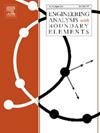三维多孔介质中带有重力和毛细力的油水两相流的新型无网格数值模拟
IF 4.2
2区 工程技术
Q1 ENGINEERING, MULTIDISCIPLINARY
Engineering Analysis with Boundary Elements
Pub Date : 2024-09-26
DOI:10.1016/j.enganabound.2024.105975
引用次数: 0
摘要
本文提出了一种新颖的全隐式方案,利用无网格广义有限差分法(GFDM)模拟具有重力和毛细力的三维(3D)油水两相流。该方法结合了时间上的隐式欧拉方案和空间上的 GFDM 离散方法,以计算流量控制方程中压力和饱和度的隐式解。研究引入了 L2 准则误差公式,并对笛卡尔节点配置方案中不同影响域半径对计算精度的影响进行了敏感性分析。研究结果表明,影响域半径越大,计算精度越低,这为在三维 GFDM 应用中选择影响域半径提供了初步指导。总之,本文提出了一种有效而精确的无网格方法来解决三维多孔介质中的两相流难题,凸显了 GFDM 在数值模拟中的广阔前景。本文章由计算机程序翻译,如有差异,请以英文原文为准。
A novel meshless numerical simulation of oil-water two-phase flow with gravity and capillary forces in three-dimensional porous media
This paper presents a novel fully implicit scheme for simulating three-dimensional (3D) oil-water two-phase flow with gravity and capillary forces using the meshless generalized finite difference method (GFDM). The approach combines an implicit Eulerian scheme in time with a GFDM discretization method in space to compute implicit solutions for the pressure and saturation in the flow control equations. The research introduces an L2 norm error formula and conducts a sensitivity analysis on the impact of varying influence domain radii on computational accuracy within the Cartesian node collocation scheme. Findings suggest that larger influence domain radii correspond to reduced computational accuracy, providing a preliminary guideline for selecting the domain radius in 3D GFDM applications. Overall, this paper presents an effective and precise meshless method for addressing two-phase flow challenges in 3D porous media, highlighting the promising prospects of GFDM in numerical simulations.
求助全文
通过发布文献求助,成功后即可免费获取论文全文。
去求助
来源期刊

Engineering Analysis with Boundary Elements
工程技术-工程:综合
CiteScore
5.50
自引率
18.20%
发文量
368
审稿时长
56 days
期刊介绍:
This journal is specifically dedicated to the dissemination of the latest developments of new engineering analysis techniques using boundary elements and other mesh reduction methods.
Boundary element (BEM) and mesh reduction methods (MRM) are very active areas of research with the techniques being applied to solve increasingly complex problems. The journal stresses the importance of these applications as well as their computational aspects, reliability and robustness.
The main criteria for publication will be the originality of the work being reported, its potential usefulness and applications of the methods to new fields.
In addition to regular issues, the journal publishes a series of special issues dealing with specific areas of current research.
The journal has, for many years, provided a channel of communication between academics and industrial researchers working in mesh reduction methods
Fields Covered:
• Boundary Element Methods (BEM)
• Mesh Reduction Methods (MRM)
• Meshless Methods
• Integral Equations
• Applications of BEM/MRM in Engineering
• Numerical Methods related to BEM/MRM
• Computational Techniques
• Combination of Different Methods
• Advanced Formulations.
 求助内容:
求助内容: 应助结果提醒方式:
应助结果提醒方式:


